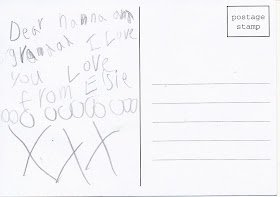 |
| The desire to write appears early |
After 30+ years reading the research of others and doing my own research as well, I can conclude that if a child is read to, and eventually begins to read themselves, that there will be an influence on writing. So what does this mean for teachers and parents of young children? In simple terms, it means that reading to and with your children is critical, as is talk, word play and use of language in all its forms. It has an impact on writing and also learning. Here are eight ways it does this.
 |
| Photo from TTALL Literacy Project |
2. Reading offers models for writing - But reading also introduces us to varied ways to share a story, and how to start a story and end it. It helps us to learn how to develop a character, the art of description, humour, rhyme and rhythm. Dr Seuss is a master at such lessons.
3. Reading teaches us about 'readership' -When children begin to have books read to them and later to read them for themselves, they begin to realize that these stories have been written for them, the reader. Good writing requires a sense of audience, and stories read teach this. When my granddaughter Elsie began receiving letters from family she suddenly wanted to write letters herself. She learned that you write for readers and that this is enjoyable and strengthens relationships.
4. Reading enriches language - There is no doubt that reading feeds children's writing. It introduces children to new words, novel use for old words, and the ever so important need to 'play' with language if you are to be a successful writer. Robert Ingpen's book 'The Idle Bear' demonstrates this well. It is essentially a conversation between two bears. He starts this way:
Later in the story a very confused bear asks:"What kind of bear are you?" asked Ted
"I'm an idle Bear."
"But don't you have a name like me?"
"Yes, but my name is Teddy. All bears like us are called Teddy."
"Where do you come from, Ted?"
"From an idea," said Ted definitely.
"But ideas are not real, they are only made-up," said Teddy. "You have to come from somewhere real to have realitives."
"Not realitives, relatives!" said Ted trying to hide his confusion.
 |
| Elsie's TV instructions |
Elsie's 'TV Instructions' (left) is a priceless set of instructions that she wrote for her Nanna just before she went to bed, so that Nanna could watch her favourite programs while babysitting.
6. Reading helps us to understand the power of words - Stories and other texts quickly teach children that words can have power. Signs give clear instructions in powerful ways - STOP, BEWARE OF THE DOG, CHILDREN CROSSING, KEEP OUT. But well-chosen words express emotions too - "I love you", "It was dark and scary". Children also discover that words can do other things. With help they will enjoy discovering language forms like onomatopoeia, e.g. atishoo, croak, woof, miaow, sizzle, rustle etc.
 |
8. Reading helps us to imagine and think - As children are introduced to varied literary genres and traditions, imaginations are awakened to the realms of fantasy, time travel, recreation of life in other times, the perils of travel through space. But at a more realistic level, reading can help young writers to imagine childhood in other places and times, 'within' the bodies of other people and with varied life roles. Through reading, children are given the examples and the fuel to imagine and write about themselves in the shoes of others, sharing their life circumstances as well as their challenges, fears and hopes.
I'd be keen to hear of your experiences with young writers and the way reading has been related to the writing of children you have taught.
You can read my other posts on writing HERE
(i) Cairney, T.H. (1983) Reading and writing: Making connections, paper presented to the 9th Australian Reading Association Conference, Launceston (Tas), September 10-14.


I printed this out and files it for future references. Lots of excellent points and I can see myself using a few in the future
ReplyDeleteThanks Sandy, nice to hear from you. Glad you liked the post. Hope your writing is going well.
ReplyDelete